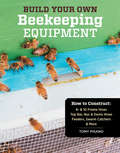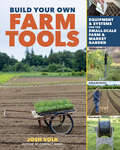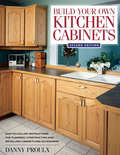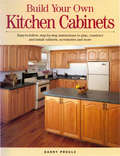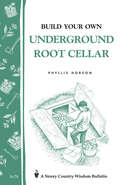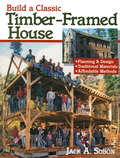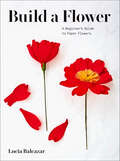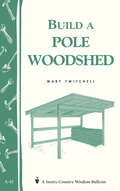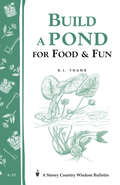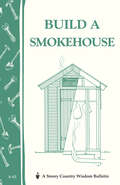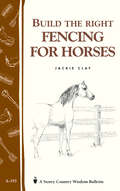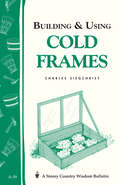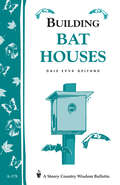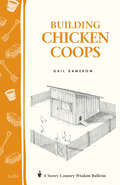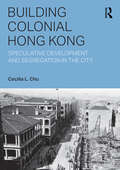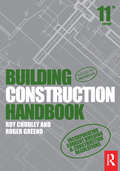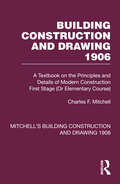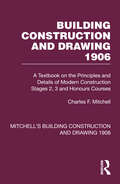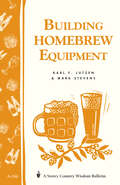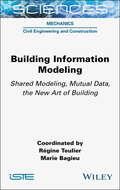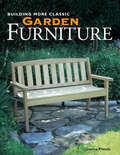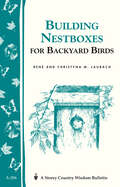- Table View
- List View
Build Your Own Beekeeping Equipment: How to Construct 8- & 10-Frame Hives; Top Bar, Nuc & Demo Hives; Feeders, Swarm Catchers & More
by Tony PisanoSave time and money by building your own beekeeping equipment. Learn to craft equipment that is tailored to your particular climate and setup. Full of insightful tips and covering a variety of hive types, Pisano includes all the basic infrastructure you need to keep your bees happy and active — and your pantry full of honey.
Build Your Own Farm Tools: Equipment & Systems for the Small-Scale Farm & Market Garden
by Josh VolkJosh Volk, author of the best-selling Compact Farms, offers small-scale farmers an in-depth guide to building customized equipment that will save time and money and introduce much-needed efficiencies to their operations. Volk begins with the basics, such as setting up a workshop and understanding design principles, mechanical principles, and materials properties, then presents plans for making 15 tools suited to small-farm tasks and processes. Each project includes an explanation of the tool&’s purpose and use, as well as the time commitment, skill level, and equipment required to build it. Projects range from the super-simple (requiring a half-day to build) to the more complex, and include how-to photographs and illustrations with variations for customizing the finished implement. Along with instructions for building items such as simple seedling benches, a mini barrel washer, a DIY germination chamber, and a rolling pack table, Volk addresses systems design for farm efficiency, including how to design an effective drip irrigation system and how to set up spreadsheets for collecting important planning, planting, and market data. This publication conforms to the EPUB Accessibility specification at WCAG 2.0 Level AA.
Build Your Own Home Office Furniture
by Danny ProulxBuild your own home office furniture!You want the best for your home office, from practical workstations to stylish bookcases. Danny Proulx shows you how to transform any room into the perfect workspace, offering invaluable tips and advice, plus 13 fresh, functional, fun-to-build projects packed with detailed photographs and step-by-step instructions.Designs range from simple storage modules to a computer desk/workstation, so whatever your level of skill, you'll find plenty of woodshop excitement. It's the kind of furniture that makes the office of your dreams...a reality.Projects include: • File and Storage Drawer Module • Lateral File Cabinet • Basic Workstation • Executive Work Center • Credenza and Bookcase Hutch • Armoire Work Center • Office Bookcase • Desktop Organizer • Media Storage Center • Closet Work Center • Stand-Up Desk • Writing Desk • Laminate Tabletop Construction
Build Your Own Kitchen Cabinets
by Danny ProulxBuild your own kitchen cabinets! You don't need a showroom full of equipment or expertise in calculus to build your own kitchen cabinets. In fact, Danny Proulx's concise, easy-to-follow instructions enable you to create incredible kitchens with just a few power tools-a table saw, circular saw, router and drill. Completely revised and updated, Build Your Own Kitchen Cabinets, Second Edition, provides start-to-finish guidelines for crafting upper and lower cabinets, plus practical information on kitchen design, material selection and tool shortcuts. Proulx's instruction is practical, easy to understand and time-tested, refined in his own shop, and taught by him in countless seminars and workshops. You'll learn how to plan, design, construct and install your own complete handmade kitchen, from simple cabinets and over-the-sink cupboards to lazy-Susan shelving, stemware, storage and more: Combine the beauty of traditional face-frame cabinetry with the strength and simplicity of European cabinetry and hardware Build drawers, pull-outs and flip-outs to maximize storage space Use European hinges, adjustable legs and other specialized hardware to take the guesswork out of construction and installation Use simple butt joints to build strong cabinets quickly Customize your cabinets' looks with a variety of door styles, countertops and finishes Page after page, Danny Proulx proves that you can build your own beautiful kitchen cabinets.
Build Your Own Kitchen Cabinets
by Danny RubieSuperbly detailed, this step-by-step guide walks readers through the stages of planning, design, construction and installation. It makes it all possible, even with only a few basic tools. And its practical, one-foot-after-the-other approach anticipates the readers' questions and concerns every step of the way.
Build Your Own Underground Root Cellar: Storey Country Wisdom Bulletin A-76 (Storey Country Wisdom Bulletin Ser.)
by Phyllis HobsonSince 1973, Storey's Country Wisdom Bulletins have offered practical, hands-on instructions designed to help readers master dozens of country living skills quickly and easily. There are now more than 170 titles in this series, and their remarkable popularity reflects the common desire of country and city dwellers alike to cultivate personal independence in everyday life.
Build a Classic Timber-Framed House: Planning & Design/Traditional Materials/Affordable Methods
by Jack A. SobonBuild a classic, enduring, and affordable home. With Jack A. Sobon’s careful guidance, you can construct your own timber-framed house in the traditional hall-and-parlor style. From felling trees to cutting timbers, and frame construction to door selection, you’ll find Sobon’s professional advice and hand-drawn illustrations invaluable. Whether you’re a first-time builder or a seasoned contractor looking to expand your repertoire, you’ll find answers to all your timber-frame questions. Open the front door and walk into the home of your dreams.
Build a Flower: A Beginner's Guide to Paper Flowers
by Lucia BalcazarLearn to create beautiful, long-lasting paper flowers in a matter of minutes for gifts, decorations, and more, with this step-by-step guide. Paper flowers are ideal for any crafter: The results are stunning but the steps to get there are achievable at any skill level. Build a Flower will teach the basic techniques needed for crafting paper flowers, building upon skills as it moves through a select number of flowers and focusing on key tips: what type of paper works best, petal shapes that work for multiple flowers, how to assemble, and more. With photographs and step-by-step instructions as their guide, readers will learn to build five flowers, variation ideas for their coloring, and final arrangements. And the designs and ideas will inspire crafters to think beyond the vase—paper flowers as gifts, as decorations, and more. This beginner book will open the door to a wide variety of possibilities and will help establish a new audience well versed in the craft, returning time and again to this book’s pages for inspiration and encouragement.
Build a Pole Woodshed: Storey Country Wisdom Bulletin A-42 (Storey Country Wisdom Bulletin Ser.)
by Mary TwitchellSince 1973, Storey's Country Wisdom Bulletins have offered practical, hands-on instructions designed to help readers master dozens of country living skills quickly and easily. There are now more than 170 titles in this series, and their remarkable popularity reflects the common desire of country and city dwellers alike to cultivate personal independence in everyday life.
Build a Pond for Food & Fun: Storey's Country Wisdom Bulletin A-19 (Storey Country Wisdom Bulletin Ser.)
by D. J. YoungSince 1973, Storey's Country Wisdom Bulletins have offered practical, hands-on instructions designed to help readers master dozens of country living skills quickly and easily. There are now more than 170 titles in this series, and their remarkable popularity reflects the common desire of country and city dwellers alike to cultivate personal independence in everyday life.
Build a Smokehouse: Storey Country Wisdom Bulletin A-81 (Storey Country Wisdom Bulletin Ser.)
by Ed EpsteinSince 1973, Storey's Country Wisdom Bulletins have offered practical, hands-on instructions designed to help readers master dozens of country living skills quickly and easily. There are now more than 170 titles in this series, and their remarkable popularity reflects the common desire of country and city dwellers alike to cultivate personal independence in everyday life.
Build the Right Fencing for Horses: Storey's Country Wisdom Bulletin A-193 (Country Wisdom Bulletin Ser. #Vol. 193)
by Jackie ClaySince 1973, Storey's Country Wisdom Bulletins have offered practical, hands-on instructions designed to help readers master dozens of country living skills quickly and easily. There are now more than 170 titles in this series, and their remarkable popularity reflects the common desire of country and city dwellers alike to cultivate personal independence in everyday life.
Building & Using Cold Frames: Storey Country Wisdom Bulletin A-39 (Storey Country Wisdom Bulletin Ser.)
by Charles SiegchristSince 1973, Storey's Country Wisdom Bulletins have offered practical, hands-on instructions designed to help readers master dozens of country living skills quickly and easily. <P><P>There are now more than 170 titles in this series, and their remarkable popularity reflects the common desire of country and city dwellers alike to cultivate personal independence in everyday life.
Building Bat Houses: Storey's Country Wisdom Bulletin A-178 (Storey Country Wisdom Bulletin Ser.)
by Dale Evva GelfandSince 1973, Storey's Country Wisdom Bulletins have offered practical, hands-on instructions designed to help readers master dozens of country living skills quickly and easily. There are now more than 170 titles in this series, and their remarkable popularity reflects the common desire of country and city dwellers alike to cultivate personal independence in everyday life.
Building Chicken Coops: Storey Country Wisdom Bulletin A-224 (Storey Country Wisdom Bulletin Ser.)
by Gail DamerowSince 1973, Storey's Country Wisdom Bulletins have offered practical, hands-on instructions designed to help readers master dozens of country living skills quickly and easily. There are now more than 170 titles in this series, and their remarkable popularity reflects the common desire of country and city dwellers alike to cultivate personal independence in everyday life.
Building Colonial Hong Kong: Speculative Development and Segregation in the City (Planning, History and Environment Series)
by Cecilia L. ChuIn the 1880s, Hong Kong was a booming colonial entrepôt, with many European, especially British, residents living in palatial mansions in the Mid-Levels and at the Peak. But it was also a ruthless migrant city where Chinese workers shared bedspaces in the crowded tenements of Taipingshan. Despite persistent inequality, Hong Kong never ceased to attract different classes of sojourners and immigrants, who strived to advance their social standing by accumulating wealth, especially through land and property speculation. In this engaging and extensively illustrated book, Cecilia L. Chu retells the ‘Hong Kong story’ by tracing the emergence of its ‘speculative landscape’ from the late nineteenth to the early decades of the twentieth century. Through a number of pivotal case studies, she highlights the contradictory logic of colonial urban development: the encouragement of native investment that supported a laissez-faire housing market, versus the imperative to segregate the populations in a hierarchical, colonial spatial order. Crucially, she shows that the production of Hong Kong’s urban landscapes was not a top-down process, but one that evolved through ongoing negotiations between different constituencies with vested interests in property. Further, her study reveals that the built environment was key to generating and attaining individual and collective aspirations in a racially divided, highly unequal, but nevertheless upwardly mobile, modernizing colonial city.
Building Construction Handbook: Incorporating Current Building And Construction Regulations (Building Construction Handbook Ser.)
by Roy Chudley Roger GreenoIdeal for students on all construction courses Topics presented concisely in plain language and with clear drawings Updated to include revisions to Building and Construction regulations The Building Construction Handbook is THE authoritative reference for all construction students and professionals. Its detailed drawings clearly illustrate the construction of building elements, and have been an invaluable guide for builders since 1988. The principles and processes of construction are explained with the concepts of design included where appropriate. Extensive coverage of building construction practice, techniques, and regulations representing both traditional procedures and modern developments are included to provide the most comprehensive and easy to understand guide to building construction. This new edition has been updated to reflect recent changes to the building regulations, as well as new material on the latest technologies used in domestic construction. Building Construction Handbook is the essential, easy-to-use resource for undergraduate and vocational students on a wide range of courses including NVQ and BTEC National, through to Higher National Certificate and Diploma, to Foundation and three-year Degree level. It is also a useful practical reference for building designers, contractors and others engaged in the construction industry.
Building Construction and Drawing 1906: A Textbook on the Principles and Details of Modern Construction First Stage (Or Elementary Course) (Mitchell's Building Construction and Drawing)
by Charles F. MitchellOriginally published in 1881, but here reissuing the 1906 edition with a new introduction by Stephen J. Scaysbrook, the Mitchell Building and Construction books offer an unparalleled insight into construction techniques and materials. Originally written to provide a concise handbook and guide for students and for practitioners, this reissue of Mitchell’s 1906 First Stage or Elementary Course edition now provides a valuable addition to building pathology, allowing students and practitioners to research construction methods and materials pertinent to the period. Including over 1000 drawings, it is of no surprise to see Mitchell’s First Stage or Elementary edition start with a detailed explanation of the instruments and methods of drawing with pencil ink and tracing paper, emphasising the need to learn basic drawing skills and the need to think about a detail and the materials used to create a detail capable of lasting well over 100 years or more. The simple act of making a scale from a drawing with only one dimension may be lost to modern-day students, but not to Charles Mitchell, who describes the method and its use.
Building Construction and Drawing 1906: A Textbook on the Principles and Details of Modern Construction Stages 2, 3 and Honours Courses (Mitchell's Building Construction and Drawing)
by Charles F. MitchellOriginally published in 1881, but here reissuing the 1906 edition with a new introduction by Stephen J. Scaysbrook, the Mitchell’s Building and Construction Stage 2, 3 and Honours book offers an unparalleled insight into historic construction techniques and materials. Originally written to provide a concise handbook and guide for students and for practitioners, this reissue of Mitchell’s 1906 Advanced and Honours edition now provides a valuable addition to building pathology, allowing students and practitioners to research construction methods and materials pertinent to the period.
Building Democracy
by Graham TowersBuilding Democracy is a major contribution to the growing public debate about the revival of community values in the face of the self-evident short-comings of the free market, specifically in terms of community architecture. Providing a historical context and an authoritative account of a movement that is proving surprisingly extensive and enduring, the book also examines the relevance of the approach to today's social and environmental problems, particularly in the inner cities. Community architecture was promoted in the early 1980s as the achievement of a handful of pioneering architects finding new ways of working with groups of ordinary people, to help them develop their own homes and community facilities. Building Democracy records the achievements of this movement and analyzes its contribution in addressing the problems of inner cities. Beginning with the origins of the urban question in the industrialization of the 19th century, the book goes on to look at the large-scale urban redevelopment of the 1960s - the latest and most concerted attempt to remodel Victorian cities, and on to community action, from which grew new approaches to design, development and construction. This book is of practical value to planners, architects, surveyors and landscape designers concerned with socially relevant design, as students or professionals. It will also be of interest to many people in the voluntary sector and in local government.
Building Homebrew Equipment: Storey's Country Wisdom Bulletin A-186 (Storey Country Wisdom Bulletin Ser.)
by Mark Stevens Karl F. LutzenSince 1973, Storey's Country Wisdom Bulletins have offered practical, hands-on instructions designed to help readers master dozens of country living skills quickly and easily. There are now more than 170 titles in this series, and their remarkable popularity reflects the common desire of country and city dwellers alike to cultivate personal independence in everyday life.
Building Information Modeling: Shared Modeling, Mutual Data, the New Art of Building
by Marie Bagieu Régine TeulierThis book presents how Building Information Modeling (BIM) and the use of shared representation of built assets facilitate design, construction and operation processes (ISO 19650). The modeling of public works data disrupts the art of construction. Written by both academics and engineers who are heavily involved in the French research project Modélisation des INformations INteropérables pour les INfrastructues Durables (MINnD) as well as in international standardization projects, this book presents the challenges of BIM from theoretical and practical perspectives. It provides knowledge for evolving in an ecosystem of federated models and common data environments, which are the basis of the platforms and data spaces. BIM makes it possible to handle interoperability very concretely, using open standards, which lead to openBIM. The use of a platform allows for the merging of business software and for approaches such as a Geographic Information System (GIS) to be added to the processes. In organizations, BIM meets the life cycles of structures and circular economy. It is not only a technique that reshapes cooperation and trades around a digital twin but can also disrupt organizations and business models.
Building Life Skills
by Louise A. Liddell Yvonne S. GentzlerBuilding Life Skills gives the tools you need to manage your life and helps you develop skills throughout your life. It contains eight parts and each part helps you develop different skills to build a satisfying life now and in the future. They help exploring relationships, managing time, understanding children, improving health and nutrition, selecting and preparing a variety of foods, caring for clothes, caring for home, improving leadership skills and career possibilities.
Building More Classic Garden Furniture
by Danny ProulxClassic Garden Furniture You Can Truly Build!Transform your garden or patio into a cozier, more inviting place to relax with family and friends by making these classic outdoor furniture projects. Whether you're building a planter, bench or table you'll find designs that are practical, attractive and a pleasure to make.Even better, these 15 exciting new projects from author and master woodworker Danny Proulx are broken down into easy-to-follow instructions with step-by-step color photos and schematic drawings.Proulx designs each project to highlight one joint, construction technique or assembly process, enabling you to build upon skills you already have and learn new ones that will take your woodworking to the next level.Proulx also gives you creative freedom by showing a basic technique, and then suggesting interesting alternative methods for achieving the same end result. He'll encourage you to have fun, experiment and turn your garden, patio or yard into your favorite "room" of the house.Projects range from easy to intermediate, including: • Beautiful Planters • Benches and Screens • Elegant Tables • And other garden classics!
Building Nest Boxes for Backyard Birds: Storey's Country Wisdom Bulletin A-206 (Storey Country Wisdom Bulletin Ser.)
by Christyna M. Laubach René LaubachThis concise guide offers easy-to-follow, step-by-step instructions for building eight different nestboxes. Each nestbox is designed to attract and house different kinds of backyard birds, including bluebirds, swallows, wrens, chickadees, nuthatches, Red-Bellied Woodpeckers, Northern Flickers, Wood Ducks, Hooded Mergansers, American Kestrals, Screech Owls, Northern Saw-Whet Owls, and Great Crested or Ash-Throated Flycatchers.
